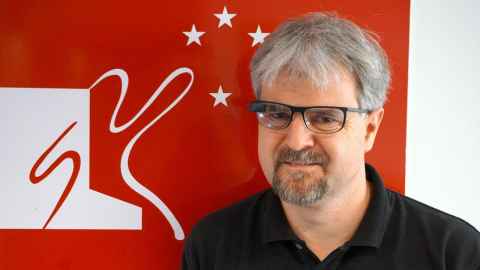A very real achievement in virtual reality
27 March 2019
Professor Mark Billinghurst of the Auckland Bioengineering Institute (ABI), has received global recognition for his lifetime contribution to human-computer interaction for augmented and virtual reality

Professor Billinghurst was presented with the Virtual Reality Career Award this week in Osaka, Japan. It is the highest award given by the Graphics Technical Committee, a constituency of the Institute of Electrical and Electronics Engineers (IEEE) Society, the largest association of technical professionals, with over 400,000 members globally.
Professor Billinghurst, Director of the Empathic Computing Laboratory at the University of Auckland and at the University of South Australia, Adelaide, is internationally renowned for his research in both Augmented Reality (AR), the technology that bridges the gap between the digital and the physical world, and Virtual Reality (VR), which places people into an imagined world such as a video game.
He has won numerous awards in his 25 years working in this area, but being recognised by his peers for his contribution over a whole career of research is a particular honour. “I was very humbled and surprised to receive it,” he says.
Professor Billinghurst’s commercialisation of AR dates back to his PhD at the University of Washington in 2000, when he co-created the ARToolkit Augmented Reality tracking software, which brought AR into the hands of millions, and created some of the first collaborative AR experiences.
It was the first of many firsts; he also developed the first collaborative mobile phone AR experiences, and the AR MagicBook technology, a mixed reality interface in which a vision-based tracking method overlaps virtual models on real book pages.
Professor Billinghurst joined the ABI last year under the Entrepreneurial Universities programme, where he and his team are exploring how AR can be combined with physiological sensing, to develop next generation teleconferencing experiences.
“AR enables new types of teleconferencing that have not been possible before,” he says. “For example, using AR you can create the illusion that a remote person is part of your real world, rather than being seen on a handheld display or desktop screen. In this way remote teleconferencing can become more like face to face conversation.”
"In the future we will be able to use AR and VR technology to see through someone else’s eyes."
The overall aim with Empathic Computing is to develop systems that enable people to better share understanding at a distance, he says.
“So one person can share what they are seeing, hearing and, especially, feeling with another. In the future we will be able to use AR and VR technology to see through someone else’s eyes while they are performing a real world activity, and know how they are feeling at the time.”
His research involves using physiological sensors to measure people’s emotional and cognitive state, and convey that to a remote collaborator.
“For example, measuring heart rate to know when a person is feeling excited. Researchers at the ABI have a lot of expertise in sensor design, data processing and measurement, and so my work connects very well with what is going on here.”
Want to help us make a difference?
There are many ways you can make a difference and support the Auckland Bioengineering Institute - you can make a donation or bequest, or even subscribe to our newsletter.